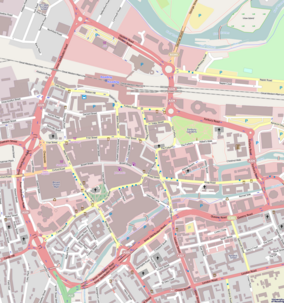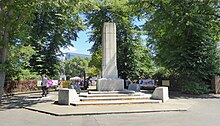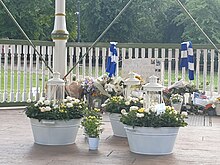
Reading is a town in Berkshire, England. Most of its built-up area lies within the Borough of Reading, although some outer suburbs are parts of neighbouring unitary authority areas. Located in the Thames Valley at the confluence of the rivers Thames and Kennet, Reading is 40 miles (64 km) east of Swindon, 25 miles (40 km) south of Oxford, 40 miles (64 km) west of London and 16 miles (26 km) north of Basingstoke.

Reading Abbey is a large, ruined abbey in the centre of the town of Reading, in the English county of Berkshire. It was founded by Henry I in 1121 "for the salvation of my soul, and the souls of King William, my father, and of King William, my brother, and Queen Maud, my wife, and all my ancestors and successors." In its heyday the abbey was one of Europe's largest royal monasteries. The traditions of the Abbey are continued today by the neighbouring St James's Church, which is partly built using stones of the Abbey ruins.

The Royal County of Berkshire, commonly known as simply Berkshire, is a ceremonial county in South East England. It is bordered by Oxfordshire to the north and the north-west, Buckinghamshire to the north-east, Greater London to the east, Surrey to the south-east, Hampshire to the south, and Wiltshire to the west. Reading is the largest settlement and the county town.
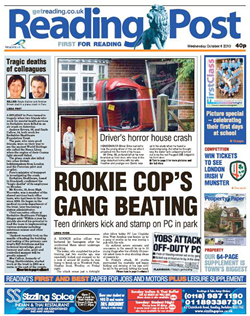
The Reading Post was an English local newspaper covering Reading, Berkshire and surrounding areas. The title page of the paper featured the Maiwand Lion, a local landmark at Forbury Gardens. The paper was most recently published by Surrey & Berkshire Media Ltd., a division of Trinity Mirror plc.
The 66th (Berkshire) Regiment of Foot was an infantry regiment of the British Army, raised in 1756. Under the Childers Reforms it amalgamated with the 49th (Hertfordshire) Regiment of Foot to form the Princess Charlotte of Wales's in 1881.

The Maiwand Lion is a sculpture and war memorial in the Forbury Gardens, a public park in the town of Reading, in the English county of Berkshire. The statue was named after the Battle of Maiwand and was unveiled in December 1886 to commemorate the deaths of 329 men from the 66th (Berkshire) Regiment of Foot during the campaign in the Second Anglo-Afghan War in Afghanistan between 1878 and 1880. It is sometimes known locally as the Forbury Lion.

George Blackall Simonds was an English sculptor and director of H & G Simonds Brewery in Reading in the English county of Berkshire.

St Laurence's Church is a Church of England mission and former parish church in the town of Reading in the English county of Berkshire. It is situated alongside the site of Reading Abbey, formerly bounded by the main Compter Gate to the south and the Hospitium of St John to the north. What was once the private chapel of the latter institution still remains in the north aisle. The church is a Grade I listed building.
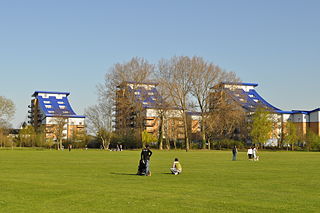
King's Meadow is a park in Reading, Berkshire, England, located next to the River Thames. It stretches from the Coal Woodland to King's Meadow Road near Reading Bridge. The Thames Path long distance footpath runs through the length of King's Meadow, which is visible from the railway when entering or leaving Reading railway station from the eastern side.

The Abbey Gateway was originally the inner gateway of Reading Abbey, which today is a large, mostly ruined abbey in the center of the town of Reading, in the English county of Berkshire. The gateway adjoins Reading Crown Court and Forbury Gardens and is one of only two abbey buildings that have survived intact, the other being the Hospitium of St John the Baptist. It is a grade I listed building, and includes a porters lodge on the ground floor and a large open room above the gate.
Barrow Park is a 45-acre public park in Barrow-in-Furness, Cumbria, England. It is located entirely within the Parkside ward, to which the park lends its name, bound by Abbey Road, Park Drive, Greengate Street and Park Avenue. Barrow Park was designed by Thomas Mawson in 1908 and was constructed in stages over the following two decades. Originally sited on the outskirts of Barrow, the park is now more or less central due to rapid growth of the town northwards during the early 20th century. It is designated by Historic England as Grade II on the Register of Historic Parks and Gardens.

The Roseate Reading Hotel is a boutique hotel in Reading, Berkshire, England. It is situated in the Forbury, formerly a part of Reading Abbey, and on the southern side of the modern Forbury Gardens. The building that forms the front section of the hotel was the Shire Hall for the County of Berkshire, built in 1911 and used as such until 1981, and is a grade II listed building.
Occupation at the site of Reading may date back to the Roman period, possibly as either a trading port on the River Thames, or as an intersection on the Roman road connecting London with Calleva Atrebatum near Silchester.
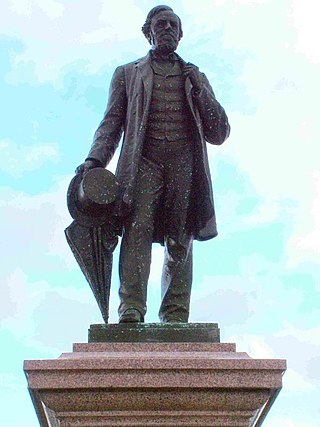
The statue of George Palmer stands in Palmer Park, in Reading, Berkshire. The statue, by George Blackall Simonds, was unveiled on 4 November 1891, though it was originally in Broad Street and only later moved to Palmer Park. The statue has been classed Grade II Listed monument since 14 December 1978.

The statue of Queen Victoria stands at the western end of Friar Street outside the Town Hall of Reading, Berkshire, in southern England.

The Sir Joseph Bazalgette Memorial is a memorial to the Victorian engineer Sir Joseph Bazalgette, by George Blackall Simonds. It is located on the Victoria Embankment, a few feet up river from the Hungerford Bridge and Golden Jubilee Bridges, opposite the junction with Northumberland Avenue.

The following is a timeline of the history of Reading, the county town of Berkshire in England.

On 20 June 2020, shortly before 19:00 BST, a man with a knife attacked people who were socialising in Forbury Gardens, Reading, Berkshire, United Kingdom. Three men died from their wounds, and three other people were seriously injured. A 25-year-old Libyan male refugee named Khairi Saadallah was arrested nearby shortly afterwards. Saadallah was a former member of the Libyan militant group Ansar al-Sharia. He was charged with three counts of murder and three counts of attempted murder; he pleaded guilty. In January 2021, Saadallah was sentenced to a whole-life term.


